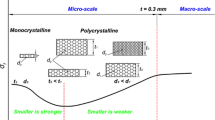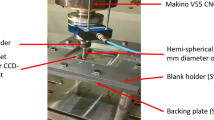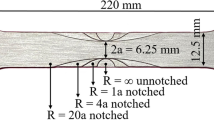Abstract
To address the difficulty in forming ultra-thin stainless steel strips, this study focuses on 304 stainless steel ultra-thin strips. By conducting tension and forming limit experiments, the basic mechanical properties and FLC (Forming Limit Curve) of the material are determined, and its formability is systematically investigated. Additionally, to improve testing efficiency and reduce resource consumption, this paper predicts the FLC forming curve of the ultra-thin strip based on the M–K ductile damage model, which is then validated against experimental results, establishing a reliable FLC prediction model. Moreover, to relate it to practical industrial production applications, this study simulates the stamping process of box-shaped components made from the ultra-thin strip based on the theoretical model, exploring the influencing factors of stamping processes on the formability of the ultra-thin strip. The research findings indicate that among the hard, semi-hard, and soft stainless steel ultra-thin strips, the soft one exhibits the best formability, and the 0.05 mm thickness is less formable compared to the 0.1 mm strip. The simulation results demonstrate that the M–K ductile damage theory can reasonably predict the formability of the ultra-thin strip. Furthermore, optimizing the chamfer size in the stamping process, reducing the friction coefficient between the die and the ultra-thin strip, and lowering the stamping speed effectively improve the formability of the ultra-thin strip.










Similar content being viewed by others
Data Availability
The datasets generated during and/or analyzed during the current study are available from the corresponding author on reasonable request.
References
Abdul-Latif, A., Abed, F., Oucif, C. H., & Voyiadjis, G. Z. (2022). Effect of various temperatures and strain-rates combinations on the thermomechanical behavior of 42CrMo steel. Archives of Mechanics, 74(5), 345–372.
Abed, F., Abdul-Latif, A., & Voyiadjis, G. Z. (2020). Performance of MMFX Steel Rebar at Elevated Temperatures. Journal of Engineering Mechanics, 146(11), 04020126.
Abed, F., Abdul-Latif, A., & Yehia, A. (2018). Experimental Study on the Mechanical Behavior of EN08 Steel at Different Temperatures and Strain Rates. Metals, 8(9), 736.
Abed, F. H., Saffarini, M. H., Abdul-Latif, A., & Voyiadjis, G. Z. (2017). Flow Stress and Damage Behavior of C45 Steel Over a Range of Temperatures and Loading Rates. Journal of Engineering Materials and Technology, 139, 021012-1–021012-8.
Bai, Y., & Wierzbicki, T. (2007). A new model of metal plasticity and fracture with pressure and Lode dependence. International Journal of Plasticity, 24(6), 1071–1096.
Chen, X., & Jiang, H. (2003). Prediction and verification of forming limit diagram in the flanging zone of automotive steel sheet. Metal Forming Technology, 21(06), 86–88.
Ding, H., Pan, J., Wan, J., et al. (2022). Influence of GTN damage parameters on the forming limit curve of DP780 steel sheet. Journal of Plasticity Engineering, 4, 151–157.
Fan, W. (2020). Research on the micromechanical behavior of deformation zone in 304 stainless steel ultra-thin strip rolling. Taiyuan University of Technology.
Hassan, A., & Abed, F. (2023a). Constitutive modeling of thermomechanical abnormalities due to dynamic strain aging in commercially pure titanium. Journal of Materials Research and Technology, 25, 5174–5183.
Hassan, A., & Abed, F. (2023). Constitutive modeling of dynamic strain aging in commercially pure bcc metals. Mechanics of Advanced Materials and Structures. https://doi.org/10.1080/15376494.2023.2236616
Li, W., Zhou, T., Liao, F., et al. (2018). Application of ductile damage criteria in dynamic time history analysis of steel frame structures. Building Structure, 22, 21–27.
Liu, D., Xu, G., & Chang, C. (2017). Forming limit diagram and its calculation model for DP780 high-strength steel sheet in warm forming. Journal of Plasticity Engineering, 24(02), 192–197.
Liu, W., Ying, L., Rong, H., et al. (2019). Prediction of forming limit of high-strength steel based on modified M–K model. Journal of Jilin University: Engineering and Technology Edition, 4, 1266–1271.
Ma, W., Guan, H., Zhang, X., et al. (2023). Preparation process and bending performance study of carbon fiber/stainless steel ultra-thin fiber metal laminates. Journal of Composite Materials, 2023, 1–12.
Morchhale, A., Badrish, A., Kotkunde, N., et al. (2021). Prediction of fracture limit of Ni–Cr based alloy under warm forming conditions using ductile damage model and numerical methods. Transactions of Nonferrous Metals Society of China, 31(08), 2372–2387.
Shahzamanian, M. M., & Wu, D. P. (2021). Study of forming limit diagram (FLD) prediction of anisotropic sheet metals using Gurson model in M–K method. International Journal of Material Forming, 14(5), 1031–1041.
Xiaoxing, L., Yangkai, C., Lihui, L., et al. (2021). A modified M–K method for accurate prediction of forming limit curve of aluminum alloy. Metals, 11(3), 1031–1041.
Yang, X. (2017). Study on prediction of forming limit in hot stamping of high-strength steel TRB box parts. Harbin Institute of Technology.
Zdzislaw, M., & Kazimierz, K. (1967). Limit strains in the processes of stretch-forming sheet metal. International Journal of Mechanical Sciences, 9(9), 3–394.
Zhang, X., Liu, C., Zheng, Y., et al. (2016). Prediction of forming limit of aluminum alloy based on ductile damage and shear damage. Journal of Jilin University: Engineering and Technology Edition, 5, 1558–1566.
Zhang, Z. (2004). Numerical simulation of tensile fracture of ductile metal cylindrical bar. Journal of Plasticity Engineering, 03, 11–14.
Zhao, F., Cheng, X., Gao, Z., et al. (2023). Influence of mold parameters on the forming damage value of SS316L stainless steel bipolar plate step-type flow channel. Journal of Plasticity Engineering, 8, 49–56.
Zheng, X., & Chen, J. (2017). Prediction and analysis of high-temperature forming limit based on M–K theory. Die & Mould Industry, 6, 1–6.
Zhou, P., Zhu, R., Shi, C., et al. (2020). GTN model-based damage modeling for warm forming of 5A06 aluminum alloy. Journal of Plasticity Engineering, 12, 164–169.
Acknowledgements
This work was supported by the Major Special Project of Science and Technology in Shanxi Province (202101120401008), the Shanxi Postgraduate Innovation Project (2022Y666), the National Key Research and Development Program (2018YFA0707305), the Shanxi Province Basic Research Program (202203021221149).
Funding
This work was supported by the Major Special Project of Science and Technology in Shanxi Province (202101120401008), Shanxi Postgraduate Innovation Project (2022Y666), Key Technologies Research and Development Program (2018YFA0707305), Shanxi Province Basic Research Program (202203021221149).
Author information
Authors and Affiliations
Contributions
Tao Fan: Methodology, Data curation, Formal analysis, Writing-original draft, Writing-review & editing. Yake Wang, Cuirong Liu, Siyuan Liu: Investigation, Data curation, Formal analysis. Yan Li: Project administration.
Corresponding author
Ethics declarations
Conflict of interest
There are no conflict to declare.
Additional information
Publisher's Note
Springer Nature remains neutral with regard to jurisdictional claims in published maps and institutional affiliations.
Supplementary Information
Below is the link to the electronic supplementary material.
Rights and permissions
Springer Nature or its licensor (e.g. a society or other partner) holds exclusive rights to this article under a publishing agreement with the author(s) or other rightsholder(s); author self-archiving of the accepted manuscript version of this article is solely governed by the terms of such publishing agreement and applicable law.
About this article
Cite this article
Fan, T., Liu, C., Wang, Y. et al. M–K Ductile Damage Theory Predicts Formability of Stainless Steel Ultra-Thin Strips in Stamping. Int J Steel Struct (2024). https://doi.org/10.1007/s13296-024-00841-8
Received:
Accepted:
Published:
DOI: https://doi.org/10.1007/s13296-024-00841-8




